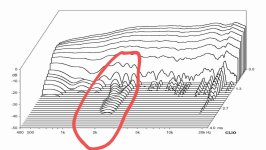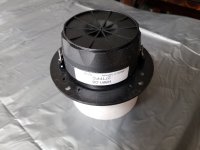Today I was listening to some small 2 ways I built for my son and noticed something odd in the mids that was bugging me, especially on solo sax and piano music. My son listens to alot of jazz, so its important to have clean mids. The drivere in the speakers were Peerless NE180 and Seas 27TFFC, crossed over 2k 2nd order.
What I noticed was a resonance around the cutoff of the tweeter and it appears to come from the back chamber. I ran my sine generator through the tweeter and sure enough when I hit just around 2k, the resonance was there. It disappeared when I put my hand on the back of the chamber. The solution was to add a piece of damping material (ie. Dynamat), which works like a charm.
Why Seas would design it that way is beyond me, saving a few grams of plastic on a $60 tweeter. At least there's a cheap fix. If you have Seas tweeters with the type of back chamber pictured below, this applies to you.
What I noticed was a resonance around the cutoff of the tweeter and it appears to come from the back chamber. I ran my sine generator through the tweeter and sure enough when I hit just around 2k, the resonance was there. It disappeared when I put my hand on the back of the chamber. The solution was to add a piece of damping material (ie. Dynamat), which works like a charm.
Why Seas would design it that way is beyond me, saving a few grams of plastic on a $60 tweeter. At least there's a cheap fix. If you have Seas tweeters with the type of back chamber pictured below, this applies to you.
Attachments
Not a steep enough crossover filter at 2khz.....in my opinion.
These are not expensive tweeters and for most of their life were priced in the $20-30 range. (Much more than that now.)
Used successfully in a lot of designs.
Dave.
These are not expensive tweeters and for most of their life were priced in the $20-30 range. (Much more than that now.)
Used successfully in a lot of designs.
Dave.
The 27TFFC otherwise sounds clean at 2k 2nd order. I did dampen Fs to make this work. I did also change the dampening inside the dome to get rid of the wiggle up at 10 - 12k and to help with the Fs peak a little.
I always thought the cheaper chambered Vifa tweeters had resonant back covers, but the Seas are much worse that way. Once the dampening is applied, they sound very nice for a cheaper tweeter.
I always thought the cheaper chambered Vifa tweeters had resonant back covers, but the Seas are much worse that way. Once the dampening is applied, they sound very nice for a cheaper tweeter.
Yeah, if you can buy a cheap Hivi tweeter that doesn't have a flimsy back chamber, it doesn't make sense Seas makes some of their driver components so cheap. The rest of the 27TFFC is engineered rather well, so something that basic spoiling the performance doesn't add up. Maybe they don't want the driver competing with the more expensive line they have. Who knows...
I like to hear more about experience of SBA tweeter resonances? Which model you had?Tweeters from SBA are by far the worst when it comes to resonating plastic cups!
Disgusting!
Was the resonance simply audible? Or did you measure and see a 2khz peak and or HD product?
Thanks for sharing this as I have 27tdfc and 27tdfc/g and 27tbfc/g varieties and reel they all have some odd peaky behaviour around 2khz. I ended up crossing all of them over at 2300 to avoid what I couldn't work out.
Ps when you say 2nd order are you talking acoustic?
Thanks for sharing this as I have 27tdfc and 27tdfc/g and 27tbfc/g varieties and reel they all have some odd peaky behaviour around 2khz. I ended up crossing all of them over at 2300 to avoid what I couldn't work out.
Ps when you say 2nd order are you talking acoustic?
Thanks for this!
Maybe that's what you experienced:

https://www.dibirama.altervista.org/home-page/tweeter/197-seas-27tffc-tweeter-1-6-ohm-200-wmax.html
Indeed, a version of this tweeter without the back chamber don't have this resonance, or is much smaller:
https://www.dibirama.altervista.org...9-seas-27tffc-tweeter-1-6-ohm-200-wmax-2.html
Maybe that's what you experienced:

https://www.dibirama.altervista.org/home-page/tweeter/197-seas-27tffc-tweeter-1-6-ohm-200-wmax.html
Indeed, a version of this tweeter without the back chamber don't have this resonance, or is much smaller:
https://www.dibirama.altervista.org...9-seas-27tffc-tweeter-1-6-ohm-200-wmax-2.html
Last edited:
Is it still hearable ? Seems below -40 dB ? Or maybe the break-ups there above - 30 dB ?
Wondered the same about the SB26 model of SBACOUSTICS with its horn. https://dibirama.altervista.org/hom...ics-sb26stwgc-4-tweeter-1-4-ohm-240-wmax.html
Wondered the same about the SB26 model of SBACOUSTICS with its horn. https://dibirama.altervista.org/hom...ics-sb26stwgc-4-tweeter-1-4-ohm-240-wmax.html
Resonance was audible with music that had isolated notes ie solos of single wind instruments, vocals and piano. The behavior wasn't linear either and very narrow banded. Mid 90s dB would really make it take off and the note that would excite it is between B and C.Was the resonance simply audible? Or did you measure and see a 2khz peak and or HD product?
Thanks for sharing this as I have 27tdfc and 27tdfc/g and 27tbfc/g varieties and reel they all have some odd peaky behaviour around 2khz. I ended up crossing all of them over at 2300 to avoid what I couldn't work out.
Ps when you say 2nd order are you talking acoustic?
Filter was 2nd order electrical. The crossovers are buried in the enclosures and a pain to remove, otherwise I'd post the part values.
That would be a fair indication of what's going on. I see that decay trail on alot of Seas tweeters and always thought it was just benign in terms of being audible that far down in amplitude. Not sure if a gated measurement would excite it enough to be noticed in severity on paper, but a steady tone higher in level will make it very noticeable to my ears, especially now that I know what to listen for. With busier music, its not as directly audible, but there is still a weird glare there which destroys the detail in the mids. Its very obvious on instrumental solos with gliding and/or sustained notes. I just wish I'd caught this on other previous builds. I have to thank my son for pointing it out.Thanks for this!
Maybe that's what you experienced:
View attachment 1159196
https://www.dibirama.altervista.org/home-page/tweeter/197-seas-27tffc-tweeter-1-6-ohm-200-wmax.html
Indeed, a version of this tweeter without the back chamber don't have this resonance, or is much smaller:
https://www.dibirama.altervista.org...9-seas-27tffc-tweeter-1-6-ohm-200-wmax-2.html
Most people wouldn't cross this tweeter that low and shallow, but with an LCR at Fs, the tweeter otherwise behaves very well at reasonable SPL limits. This was a budget build, so i wasn't expecting much from it. The NE180s don't sound that good crossed higher than 2k without a complex and steep filter, but they are really nice up to that point. I also didn't have the parts on hand to whip up a more complex xover, which was repurposed from another design using the 27TFFC - its a common tweeter i like in smaller 2 ways with a paper cone driver.
The resonance was intolerable with the speakers being used for their intended purpose, so a solution needed to be found. At least I could share my experiences with everyone here, as its sad a tweeter like this is ruined by something as basic as a cheap piece of plastic.
You built numerous speakers with this tweeter but didn't notice anything wrong until your son did. But now the resonance is intolerable and you can't unhear it?
I love this stuff. 🙂
Dave.
I love this stuff. 🙂
Dave.
Go ahead... do your worst. Shame on me for trying to be helpful.You built numerous speakers with this tweeter but didn't notice anything wrong until your son did. But now the resonance is intolerable and you can't unhear it?
I love this stuff. 🙂
Dave.
The issue wasn't that noticeable until the right type of material was being played and a fresh set of ears heard it. Think of it as drinking Budweiseer for all of your life then being served your very first glass of Bavarian Hefeweizen... you fill in the blanks..
Are you recommending that folks who've built systems with these tweeters break the seal and pry the backs off to implement your full changes? I hope not, because that could be a little intimidating for some people.
You've taken a side-eye insult at Seas design and the trade-offs they make. I don't mind constructive criticism, but I find the insulting troubling.
A Budweiser and Hefeweizen analogy? Please.
Dave.
You've taken a side-eye insult at Seas design and the trade-offs they make. I don't mind constructive criticism, but I find the insulting troubling.
A Budweiser and Hefeweizen analogy? Please.
Dave.
Well you poked at me first and I didn't say a single word about prying the chamber off of Seas tweeters, just adding some dampening to the back of them. I just mentioned its sad Seas would skimp on a little plastic which could have improved the performance considerably. Feel free to nit pick apart my input.
The beer comment wasn't intended to insult, but my German background dictates I must compare everything with beer analogies.
The beer comment wasn't intended to insult, but my German background dictates I must compare everything with beer analogies.
- Home
- Loudspeakers
- Multi-Way
- SEAS tweeter resonance problem
